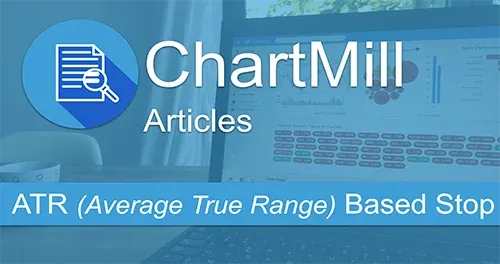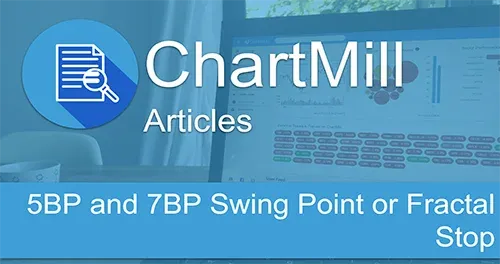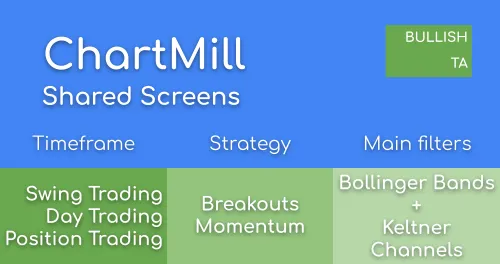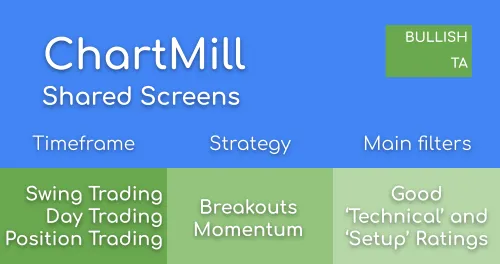General Trading Tips & FAQ
By Aldwin Keppens - reviewed by Kristoff De Turck
Last update: Apr 19, 2024
In this article we will discuss some frequently asked questions (FAQ), but also some general advice on technical trading. Although the example of the 'technical breakout setups' screen is used here, it is really about any other screen as well.
The output of any screen gives you a list of potential setups. The screener just did 90% of the work for you, but now it is up to you to find those stocks in the output that are really worth investigating further. So whathever you find on ChartMill, you should never consider it as plain trading advice and just buy and assume nothing can go wrong. We'll share some tips here on how you can find the right candidates and moments.
1) What is a Technical Setup?
With a setup we indicate that the stock is trading is a range or consolidation zone where it may break out from. A good setup means a good entry and exit point can be found on the chart. It means that whatever happens, you can put your exit in such a way thay worst case you will have a limitated loss. A setup does not predict anything about an upcoming breakout. The breakout may never happen. In the linked articles you can find more info on why consolidation zones are useful when trading technical breakouts.
2) Do these setups really work?
Good question! The "Technical Breakout Setups" section in the analyzer will find stocks in a strong uptrend which are in a consolidation period. They are found by combing the ChartMill Technical Rating and the ChartMill Setup Quality Rating. These ratings and the concepts behind these setups are described in 2 documentation entries:
- ChartMill Technical Rating and Setup Quality scores
- Trading using the ChartMill Technical and Setup Quality Ratings
But, even if these setups implement well known technical trading concepts, there is never any guarantee that the individual selection will actually be a winner. As a trader, there are many things which you should take into account and it is very important to understand that ChartMill does not magically present you some stocks which are certain to start rising after you buy them and allow you to just sit back and relax. The following items are important to understand:
- In technical trading, profit comes from the overall result. You can make a profit with a couple of bigger winners which compensate for many small losses.
- Take your loss! Solid money management is key to overall profit. This means that for every trade you enter you should know when you will take your loss and make sure this loss is only a fraction of your total portfolio. (Could be anything from 0.1 to 2% of your total capital).
- Always keep an eye on earnings releases! Stocks tend to move after a new earnings release. You can't know up front whether the move will be in your preferred direction. A possible strategy is to always make sure you are out when earnings are released.
- Long setups need support of the general market environment! When the market is in a correction phase, ChartMill will still find candidates which meet the selection, but chances of an actual successful breakout will be much lower. In general breakout setups work best in a nice and quiet market which supports breakouts.
We can elaborate a bit more on the last point because the next question is: "so how do I know we have a market which supports breakouts?". The following points can help you determine whether the market conditions are good or bad:
- Watch the indexes. This is a link to the index ETF charts. SPY is the ETF for the S&P 500 Index, QQQ is the Nasdaq 100 and IWM is the Russel 2000, which is the small cap index. The charts of the index give you a general impression on how the market is moving. You can also use the analyzer on these symbols for an automated analysis.
- Check the number of available setups. This page describes how you can run the technical breakout setup screen in the screener. The screener will output how many candidates were found in total while you only see the top 20 selection in the analyzer. If at some point in time there are only 10 or less breakout setups found, these are probably the exceptions and they have a low chance of succeeding. When there are many setups the market looks better.
- Use feedback from your trading. This is a really simple rule: when breakouts are working for you, they are working in general and you can safely look for the next candidate. When you see more and more breakouts failing, you should scale down your trading and wait for a better period.
- Monitor breakout setups. You can't trade every setup, but you can monitor them to see what happens. When you see many are working, even if you didn't trade them it tells you the climate is good for other breakout setups too.
To summarize: the point made here is that ChartMill is a tool which helps you find breakout setups, but an important task is still with the individual traders. You should be aware of market conditions and develop a method for determining when market conditions are right and always make sure you use good money management.
3) Do I need to go for setups with a perfect 10 Setup Rating and 10 TA Rating?
These can't fail right?
Of course they can fail and all of the points made above are still valid here!
But the point to be made here is that a 10/10 is a very rare and exceptional beast. The reason for this is that TA score and Setup score are somewhat contradictory to each other. When evaluating the TA score we also evaluate the short term trend and when the short term also shows a rising trend, the stock is extended from a setup point of view. (You do not want to jump into a stock which has just risen many percentages, reversal could be around the corner at any point).
The setup score looks for a consolidation, so a high setup score implies a lower score for short term trend in the TA score. In short: perfect setups will have a high TA score (above 7) which implies a strong rising overall long term trend, but a consolidation in the last days or weeks.
4) Why is the entry above the current price?
The analyzer trading setups always have an entry price above the current price. That looks stupid right? Why would you pay 51 tomorrow for something which you can buy for 50 today?
The suggested order type here is a BUY STOP order. While a stop loss (or SELL STOP) order will only execute when your stock drops below a certain number, the BUY STOP will only execute when your stock rises above a certain level.
The idea here is that you only want to buy the stock when it actually starts to rise and when it arrives above the breakout level. It is very well possible that the stock never reaches this level. It is also possible that the stock only reaches this level next week. Both cases make sure you only enter the stock when the actual breakout happens. If it doesn't happen you have prevented a loss by never entering the stock.
Important notes here are:
- Even when the stock does reach the breakout level, this is no guarantee that it will start to rise from now on. Always keep your sell stops in place.
- Both the buy and sell point suggested by ChartMill are only suggestions. When you are new at this you can use these values as they make sure your loss is limited to 1% at most. More experienced trades will of course adjust these values to their own style.
5) Why is there no target price provided?
In short: our intend/suggestion is to adjust your stop price in a trailing way after the entry. We don't know whether the breakout will stop at a certain level or after a certain amount of days or weeks. Any individual selection could just start to reverse 2 days after and still give you a loss or it could sit in your portfolio for many months and be the biggest winner of your trading career so far.
Whether or not to use a target, where to put your stops and when to move them are all elements of a personal trading strategy which will be different for every individual and is often the result of learning and experience. For searching traders (aren't we all?) we have these articles about possible stop strategies:
- Reduce Loss, Maximize Profit
- 5BP and 7BP Swing Point or Fractal Stop
- ATR based stop (chandelier stop)
6) More on Trading and Money Management?
We strongly advice taking the time to read these articles on Money Management:


















